Taxonomy: Class: Mammalia; Order: Carnivora; Family: Felidae
Description
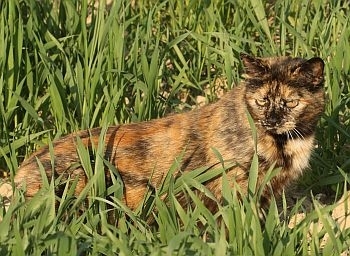
Feral cat © Nicholas Aebischer
A feral cat is a domestic cat living, at least partly, independently of humans. Feral cats are found in a wide range of habitats, from urban to woodland, farmland and upland. They eat mainly rodents and lagomorphs, but depending on location their predation on other species may pose a threat to poultry, game and other native wildlife (Woods et al. 2003). Feral cats also endanger the native wildcat through hybridisation and the spread of disease (Macdonald et al. 2004). Feral cats may be culled throughout the year, but they must be destroyed humanely because the provisions of the UK animal welfare legislation apply equally to feral cats and those kept as pets (Natural England 2010).
Further information:
Cat Chat website .
Conservation status and legislation
Status:
UK: Feral
World: Unclassified (IUCN Red List)
Legislation:
Distribution and abundance
Feral cats are most conspicuous in areas of urban development, but also occur widely in the countryside. They have been introduced to many offshore islands to control rats and rabbits. The scarcity of mapped records outside urban areas probably reflects the difficulty in separating feral from dependent domestic cats.
Estimates of feral cat abundance (numbers of individuals in the spring) across the UK, from Harris et al. (1995):
Recent trends from the National Gamebag Census
United Kingdom
Index of bag density from 1961 to 2009 (see statistical methods and interpretational considerations).
Error bars represent 95% confidence intervals.
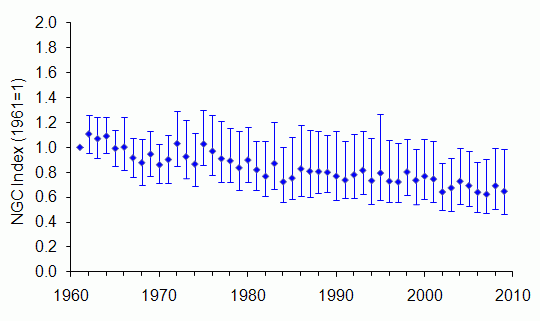
There has been a steady and significant decrease in the bag index between 1961 and 2009. It is possible that increasing fox numbers have had an effect through competition or direct predation.
Change in feral cat bags over time, with 95% confidence limits (see statistical methods):
| Country |
Sites |
Start
year |
End
year |
Change (%)
1961-2009 |
Change (%)
1984-2009 |
Change (%)
1995-2009 |
| United Kingdom |
783 |
1961 |
2009 |
-39*
-55 to -14 |
-20*
-33 to -3 |
-15
-28 to 2 |
* significant at P < 0.05
England
Index of bag density from 1961 to 2009 (see statistical methods and interpretational considerations).
Error bars represent 95% confidence intervals.
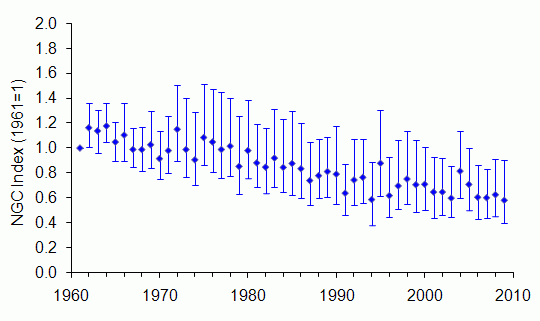
There has been a steady and significant decrease in the bag index between 1961 and 2009, amounting to a fall of approximately half. It is possible that increasing fox numbers have had an effect through competition or direct predation.
Change in feral cat bags over time, with 95% confidence limits (see statistical methods):
| Country |
Sites |
Start
year |
End
year |
Change (%)
1961-2009 |
Change (%)
1984-2009 |
Change (%)
1995-2009 |
| England |
544 |
1961 |
2009 |
-45*
-59 to -20 |
-29*
-42 to -13 |
-15
-28 to 5 |
* significant at P < 0.05
Scotland
Index of bag density from 1961 to 2009 (see statistical methods and interpretational considerations).
Error bars represent 95% confidence intervals.
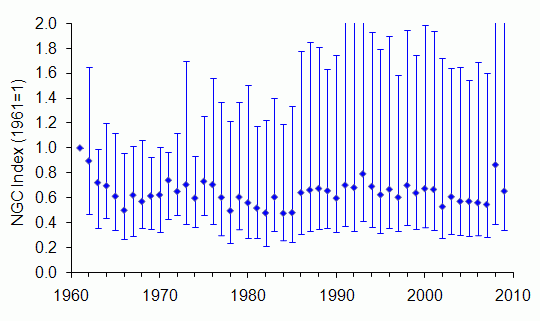
There has been no detectable change in the bag index between 1961 and 2009.
Change in feral cat bags over time, with 95% confidence limits (see statistical methods):
| Country |
Sites |
Start
year |
End
year |
Change (%)
1961-2009 |
Change (%)
1984-2009 |
Change (%)
1995-2009 |
| Scotland |
201 |
1961 |
2009 |
-29
-62 to 114 |
3
-26 to 37 |
-12
-36 to 17 |
* significant at P < 0.05
Wales
Index of bag density from 1961 to 2009 (see statistical methods and interpretational considerations).
Error bars represent 95% confidence intervals.
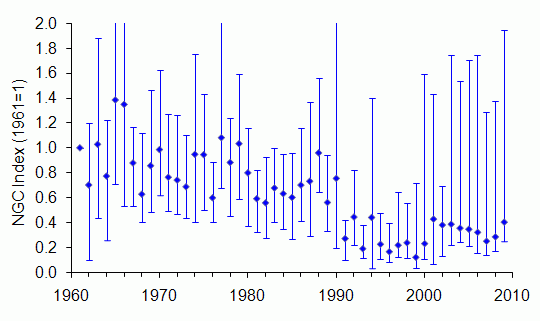
Although there has been an apparent decline in the bag index between 1961 and 2009, it is not statistically significant.
Change in feral cat bags over time, with 95% confidence limits (see statistical methods):
| Country |
Sites |
Start
year |
End
year |
Change (%)
1961-2009 |
Change (%)
1984-2009 |
Change (%)
1995-2009 |
| Wales |
24 |
1961 |
2009 |
-64
-79 to 79 |
-51
-69 to 82 |
7
-58 to 271 |
* significant at P < 0.05
N Ireland
There are too few bag records of feral cat to produce an index graph. 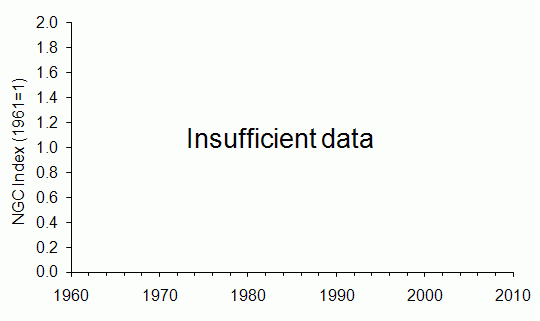
There are too few bag records of feral cat to evaluate rates of change over time
| Country |
Sites |
Start
year |
End
year |
Change (%)
1961-2009 |
Change (%)
1984-2009 |
Change (%)
1995-2009 |
| N Ireland |
Too few sites |
Environmental zones
Change in feral cat bags over time, with 95% confidence limits (see statistical methods):
| Environmental zone |
Sites |
Start
year |
End
year |
Change (%)
1961-2009 |
Change (%)
1984-2009 |
Change (%)
1995-2009 |
| Easterly lowlands (England/Wales) |
345 |
1961 |
2009 |
-58*
-72 to -39 |
-45*
-63 to -23 |
-29
-53 to 2 |
| Westerly lowlands (England/Wales) |
134 |
1961 |
2009 |
-28
-67 to 36 |
-14
-46 to 27 |
30
-14 to 77 |
| Uplands (England/Wales) |
87 |
1961 |
2009 |
-41
-74 to 94 |
-1
-25 to 40 |
-4
-23 to 24 |
| Lowlands (Scotland) |
61 |
1961 |
2009 |
-21
-61 to 48 |
0
-49 to 54 |
-8
-53 to 52 |
| Intermediate uplands/islands (Scotland) |
30 |
1961 |
2009 |
-61
-86 to 125 |
-33
-81 to 64 |
14
-60 to 117 |
| True uplands (Scotland) |
112 |
1961 |
2009 |
-35
-73 to 62 |
16
-32 to 65 |
-2
-36 to 64 |
* significant at P < 0.05
Comparison with BBS mammal data
No comparison with the NGC trend is possible because too few feral cat records are received through the Breeding Bird Survey (BBS) organised by the British Trust for Ornithology.
Long-term trend from the National Gamebag Census
There are too few bag records of feral cat to produce a trend starting before 1961.
References and further reading
- Battersby,J. (2005). UK Mammals: Species Status and Population Trends. Joint Nature Conservation Committee/Tracking Mammals Partnership, Peterborough (JNCC download page).
- Harris,S., Morris,P., Wray,S. & Yalden,D.W. (1995). A Review of British Mammals: Population Estimates and Conservation Status of British Mammals Other than Cetaceans. Joint Nature Conservation Committee, Peterborough (JNCC download page).
- Harris,S. & Yalden,D.W. (2008). Mammals of the British Isles: Handbook, 4th edition. Mammal Society, Southampton.
- Macdonald,D.W., Daniels,M.J., Driscoll,C., Kitchener,A. & Yamaguchi,N. (2004). The Scottish Wildcat: Analyses for Conservation and an Action Plan. Wildlife Conservation Research Unit, University of Oxford, Oxford.
- Natural England (2010). The Animal Welfare Act 2006: what it means for wildlife. Natural England Technical Information Note TIN072. Natural England, Peterborough (NE download page)..
- Woods,M., McDonald,R.A. & Harris,S. (2003). Predation of wildlife by domestic cats Felis catus in Great Britain. Mammal Review 33: 174-188.
This report should be cited as: Aebischer,N.J., Davey,P.D. & Kingdon,N.G. (2011). National Gamebag Census: Mammal Trends to 2009. Game & Wildlife Conservation Trust, Fordingbridge (http://www.gwct.org.uk/ngcmammals).
Return to species list
Get the Latest News & Advice
Join over 100,000 subscribers and stay updated on our latest advice, research, news and offers.
*You may change your mind any time. For more information, see our Privacy Policy.